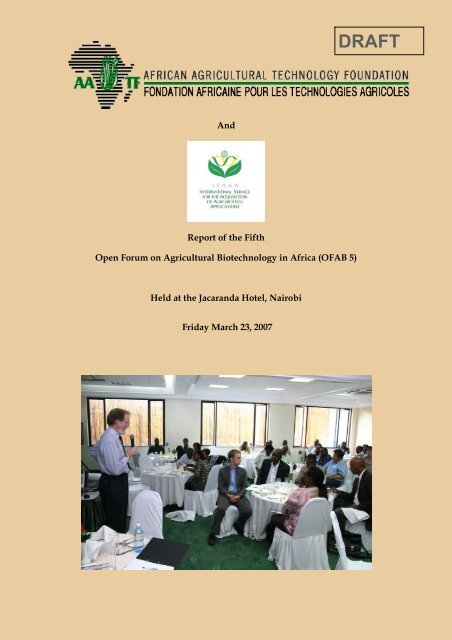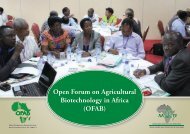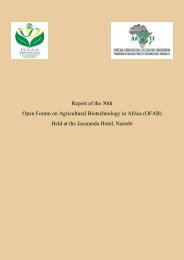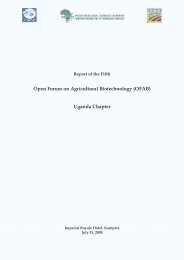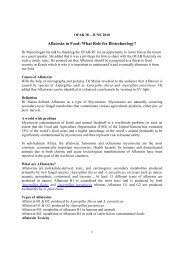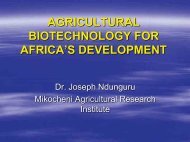Annex 1 List of Participants - OFAB
Annex 1 List of Participants - OFAB
Annex 1 List of Participants - OFAB
Create successful ePaper yourself
Turn your PDF publications into a flip-book with our unique Google optimized e-Paper software.
And<br />
Report <strong>of</strong> the Fifth<br />
Open Forum on Agricultural Biotechnology in Africa (<strong>OFAB</strong> 5)<br />
Held at the Jacaranda Hotel, Nairobi<br />
Friday March 23, 2007<br />
DRAFT<br />
1
Acknowledgements<br />
The AATF and ISAAA AfriCenter team that organised the Fifth Open Forum on<br />
Biotechnology is grateful to the guest speaker, Dr. T.J Higgins, who is the lead<br />
researcher in the project “Partnerships for Delivery <strong>of</strong> Insect Resistant Cowpea to<br />
Smallholder Farmers in Sub-Saharan Africa”. His presentation on the status <strong>of</strong> green<br />
house controlled trials <strong>of</strong> Bt cowpea was timely and quite informative. The team<br />
appreciates inputs on the discussions made by the Executive Director <strong>of</strong> AATF Dr.<br />
Mpoko Bokanga. The <strong>OFAB</strong> meeting would not have been successful without the<br />
involvement, support and active participation <strong>of</strong> the participants. We value their<br />
comments and words <strong>of</strong> encouragement. Special thanks go to Dr Margaret Karembu,<br />
Director, ISAAA AfriCenter, who ably moderated the discussions. Special<br />
recognition also goes to the efficient conference services provided by the Jacaranda<br />
Hotel.<br />
2
BACKGROUND<br />
The Open Forum on Agricultural Biotechnology in Africa (<strong>OFAB</strong>) is a platform that<br />
brings together stakeholders in biotechnology and enables interactions between<br />
scientists, journalists, the civil society, industrialists, lawmakers and policy makers.<br />
It is a monthly lunch meeting that provides an opportunity for key stakeholders to<br />
know one another, share knowledge and experiences, make new contacts and<br />
explore new avenues <strong>of</strong> bringing the benefits <strong>of</strong> biotechnology to the African<br />
agricultural sector.<br />
It also provides an opportunity to make formal presentations and informal<br />
discussions focusing on the relationships among science, technology, innovation,<br />
environment, policy, trade, benefits-sharing and their impact on economic<br />
development.<br />
The forum was launched on 14 September 2006, at the Norfolk Hotel in Nairobi,<br />
Kenya. Nairobi is ideal for <strong>OFAB</strong> as it has many universities and research<br />
institutions conducting research in the life sciences, development organisations, UN<br />
agencies, agricultural industries, farmer associations and civil society organisations.<br />
Stakeholders are encouraged to be actively involved by participating in the<br />
discussions, proposing new topics and possible speakers.<br />
Objectives <strong>of</strong> <strong>OFAB</strong><br />
<strong>OFAB</strong> has been designed to accord stakeholders a unique and dynamic opportunity<br />
to discuss all aspects <strong>of</strong> biotechnology with a view to making recommendations on<br />
how best to harness its benefits in a responsible way.<br />
The aim is to provide a platform for knowledge-sharing and awareness creation on<br />
and understanding <strong>of</strong> biotechnology. Through the forum, scientists get the much<br />
needed chance to impact policy makers on the need to mainstream science and<br />
technology on Africa’s development agenda and on the need to financially support<br />
R&D.<br />
Above all, the forum should open avenues for networking and concretizing linkages.<br />
Structure, Frequency and Venue<br />
The monthly meetings <strong>of</strong> the forum will be held at the Jacaranda Hotel in<br />
Westlands, Nairobi, every last Thursday <strong>of</strong> the month, from 12.00 noon to 2.00pm,<br />
unless otherwise stated. Lunch will be served between 12.00am and 1.00pm,<br />
followed by a 20-minute presentation by an invited speaker and 30 minutes <strong>of</strong><br />
discussions and wrap-up.<br />
3
Role <strong>of</strong> AATF<br />
The AATF will facilitate the meetings by providing venue and lunch for all the<br />
invited participants, facilitate operations <strong>of</strong> the Programming Committee, resource<br />
persons and production <strong>of</strong> the reports.<br />
Role <strong>of</strong> ISAAA<br />
ISAAA will coordinate the activities <strong>of</strong> all the <strong>OFAB</strong> Programming Committee<br />
which includes: selection <strong>of</strong> topics for each event, identification and invitation <strong>of</strong><br />
speakers, expanding participation and packaging <strong>of</strong> the presentations into<br />
information briefs.<br />
4
Overview<br />
Cowpea (Vigna unguiculata L. Walp) is rich in quality protein and digestible<br />
carbohydrate, has energy content almost equivalent to that <strong>of</strong> cereals grains and an<br />
ideal complement to the protein deficient diets <strong>of</strong> the poor.<br />
It is considered the most important food grain legume in the dry savannas <strong>of</strong> tropical<br />
Africa, where it is grown on more than 12.5 million hectares <strong>of</strong> land. Nearly 200<br />
million people in Africa consume the crop; it provides cash income, is a cheap<br />
protein supplement in human diets and a source <strong>of</strong> quality fodder for livestock.<br />
However, many biotic and abiotic factors greatly reduce cowpea productivity in the<br />
traditional African farming systems.<br />
Efforts are underway to develop improved lines <strong>of</strong> cowpea that withstand biotic and<br />
abiotic stresses, possess greater genetic vigour and contain higher nutritional value.<br />
As part <strong>of</strong> this effort, AATF is coordinating a public/private sector collaborative<br />
partnership project to promote technological interventions that will result in the<br />
improvement <strong>of</strong> cowpea productivity and utilisation in sub-Saharan Africa.<br />
To shed light on the progress that has been made so far, <strong>OFAB</strong> on Friday 23, 2007<br />
invited the lead researcher, Dr. T.J Higgins, to give a presentation on status <strong>of</strong> the<br />
project titled “Partnership for Delivery <strong>of</strong> Insect Resistant Cowpea to Smallholder Farmers<br />
in the sub-Saharan Africa” to the scientific community and other stakeholders in<br />
Kenya.<br />
Opening remarks<br />
Dr. Margaret Karembu, Director, ISAAA AfriCenter and chair,<br />
<strong>OFAB</strong> Programming Committee, opened the meeting by welcoming<br />
all the participants to the second meeting in the year 2007. She gave<br />
highlights on the program, aims <strong>of</strong> <strong>OFAB</strong> meeting and requested<br />
participants to introduce themselves.<br />
Dr. Mpoko Bokanga, Executive director, AATF, thanked the participants for having<br />
spared time from their busy schedules to attend the meeting.<br />
He gave background information, objectives, structure, frequency<br />
and venue for <strong>OFAB</strong> meetings. He said Nairobi had over 39<br />
research institutions thus <strong>of</strong>fering an ideal venue for the meetings.<br />
He thanked Dr. Karembu, for accepting the chair the <strong>OFAB</strong> as part<br />
<strong>of</strong> the collaboration between AATF and ISAAA.<br />
Dr Bokonga said AATF would source for funds to facilitate the<br />
5
meetings, while ISAAA with its vast experience in biotechnology knowledge-sharing<br />
and partnerships’ management will coordinate <strong>OFAB</strong> activities.<br />
He introduced the <strong>OFAB</strong> Programming Committee members who include;<br />
1. Dr Margaret Karembu - ISAAA - Chair<br />
2. Mrs. Nancy Muchiri - AATF<br />
3. Dr. Fred Kanampiu - CIMMYT<br />
4. Dr Eucharia Kenya - Kenyatta University<br />
5. Dr Simon Gichuki - KARI Biotech<br />
6. Dr. Dan Kiambi - ICRISAT<br />
7. Dr Wilson Songa - MOA<br />
Dr. Bokanga also introduced the guest speaker to the participants. He said “T.J.<br />
Higgins is the Deputy Chief <strong>of</strong> CSIRO’s (Commonwealth Scientific and Industrial<br />
Research Organization) Division <strong>of</strong> Plant Industry based in Canberra, Australia.<br />
Dr Higgins has a scientific background in agriculture (from Dublin, Ireland) and<br />
Plant Physiology (from University <strong>of</strong> California, Davis). His current operations are<br />
in biotechnology where he focuses on legumes such as cowpea, peas, lupine and<br />
chickpeas. He is a Fellow <strong>of</strong> the Australian Academy <strong>of</strong> Sciences.”<br />
He said the project goal was to facilitate the development, distribution and adoption<br />
<strong>of</strong> appropriate technologies that would substantially increase cowpea productivity<br />
and utilisation in sub-Saharan Africa.<br />
He informed the participants that AATF’s role was to negotiate access to the Cry1 ab<br />
gene, which confers resistance to the Maruca pod borer, provide liability protection<br />
to the technology provider, ensure high quality seed production and availability,<br />
license improved seed and technology distribution in Africa and help to develop<br />
cowpea markets.<br />
The project partners include Network for the Genetic Improvement <strong>of</strong> Cowpea for<br />
Africa (NGICA), International Institute <strong>of</strong> Tropical Agriculture (IITA), Monsanto<br />
Company, The Kirkhouse Trust, National Agricultural Research systems (NARS) in<br />
West Africa, and CSIRO-Plant Industry, Australia.<br />
6
Summary <strong>of</strong> presentation<br />
Genetic transformation <strong>of</strong> cowpea for insect resistant germplasm: Opportunities<br />
and Challenges<br />
By Dr. T.J Higgins, lead researcher in the Cowpea transformation project in Africa.<br />
Dr. T.J Higgins, the lead researcher in the Cowpea transformation<br />
project in Africa, started his presentation by informing the<br />
participants now happy he was back in Kenya as he had been in<br />
the country before as a tourist.<br />
He thanked AATF for giving him the opportunity to share with<br />
various stakeholders, the findings <strong>of</strong> the cow pea transformation<br />
project in Africa.<br />
Dr. T.J Higgins gave an insight on modern biotechnology explaining aspects <strong>of</strong><br />
cloning, gene technology (genetic modification, GM), molecular markers and<br />
cloning <strong>of</strong> GM animals. He emphasized the importance <strong>of</strong> the gene technology since<br />
it laid the foundation for the success <strong>of</strong> Bt cotton in Australia.<br />
He gave highlights on biotechnology traits in Australian cotton in the short to<br />
medium term and gave details <strong>of</strong> the source <strong>of</strong> the gene, chronology <strong>of</strong> additional<br />
insects and herbicides from 1996.<br />
He said that “in the next 10 years many crops will come up due to conventional<br />
breeding programs in many research institutions. A farmer would make USD 350<br />
per hectare which may not appear highly pr<strong>of</strong>itable but he would have cut on pest<br />
management practices.”<br />
Dr. Higgins gave an overview <strong>of</strong> regulatory control <strong>of</strong> GM crops in Australia. He<br />
said that during research and development, environmental and human safety checks<br />
are put in place through Institutional Biosafety Committee, Office <strong>of</strong> the Gene<br />
Technology Regulator and other relevant bodies before commercial release.<br />
He said that in Australia, the release <strong>of</strong> GM crops is faced with public awareness and<br />
acceptance issues. Regular subjects <strong>of</strong> controversy include; information about the<br />
technology, human safety, environmental safety, sustainability, informative labeling,<br />
control <strong>of</strong> food chain by multi-nationals and market access.<br />
He said the economic impact <strong>of</strong> GM crops from 1996-2004 was USD 27 billion. In<br />
2005, it was USD 5.25 and in 2006 it was estimated at 5.5. He reiterated that the<br />
environmental impact <strong>of</strong> GM crops between 1996 and 2004 showed a reduction <strong>of</strong><br />
172,500 tones <strong>of</strong> active pesticide ingredients that translates to a 14% reduction in<br />
environmental impact.<br />
7
Dr. Higgins said the project aims to develop a transformation system for cowpea, by<br />
introducing insect protection genes and complementing traditional cowpea breeding<br />
programmes in Africa.<br />
He explained the four main steps followed during the gene transfer to cowpeas<br />
namely: invitro culture system, genetic transformation-transient, genetic<br />
transformation-stable and transfer <strong>of</strong> useful transgenes.<br />
He said that from the tests cowpea weevils do not emerge from the transgenic lines<br />
that were fully protected. The challenge now is to determine the safety <strong>of</strong> the<br />
transformed cowpea.<br />
Dr. Higgins further said that the genes used were sourced from Monsanto and<br />
transferred to different events where it emerged that the Bt cowpea was highly toxic<br />
to Helicoverpa armigera (the target used) due to unavailability <strong>of</strong> Maruca Vitrata in<br />
Australian labs.<br />
He said cowpea transformation system was now available and reproducible. Genes<br />
for protection against stored grain and field pests were active in cowpeas indicating<br />
a pro<strong>of</strong> <strong>of</strong> the concept <strong>of</strong> insect protection in lab studies.<br />
He said that the challenges for coming up with a Bt cowpea were to access the<br />
second Bt gene, ramp-up production <strong>of</strong> Bt transgene, permission to operate,<br />
Biosafety and regulation, gene introgression and seed dissemination.<br />
He thanked the Rockefeller foundation, AATF and USAID for funding the project.<br />
Open discussions<br />
Mr. Kevin Smith, Agriculture Attaché, US<br />
Embassy, Kenya, sought to know how the<br />
researcher was able to ensure that pests do<br />
not develop resistance to the Bt genes.<br />
A: Dr. Higgins said that developing multiple<br />
resistance genes was a way <strong>of</strong> avoiding<br />
resistance.<br />
Dr. Bokanga said that insect resistance<br />
management is a long term process and that measures are normally put in place to<br />
reduce the build up <strong>of</strong> resistance during the post release process.<br />
Q: Dr. Karembu, Director ISAAA AfriCenter, Kenya, enquired the time frame for<br />
the second gene to be released and demonstrated to farmers.<br />
8
A: Dr. Higgins said that it would take 5-8 years in testing the different ecological<br />
zones in Africa for the demonstration to reach farmers.<br />
Q: Dr. Dorrington Ogoyi, Senior Lecturer, Department <strong>of</strong> Biochemistry, University<br />
<strong>of</strong> Nairobi, wondered why the main cowpea pest in Africa Maruca Vitrata was not<br />
initially the target in the development <strong>of</strong> Bt cowpea. He also wanted to know if the<br />
Bt gene Cry 1AB being used was effective against Maruca.<br />
A: Dr. Higgins said that the target Helicoverpa armigera was available in the lab and<br />
that is why it was used instead <strong>of</strong> Maruca which is not in Australia. Dr. Bokanga<br />
added that it is possible to do the tests in Africa and that discussions are on going.<br />
However, lack <strong>of</strong> regulatory structures and hindering regulations has been the main<br />
stumbling block.<br />
Q: Ms. Rachael Shibalira from the Attorney General’s Chambers, sought to know<br />
why public acceptance is a problem in Australia yet they had accepted Bt cotton.<br />
A: Dr. Higgins explained that public acceptance is the biggest challenge <strong>of</strong> all. He<br />
urged stakeholders in Africa not to underrate it. Canola was approved by regulators<br />
but the public had mixed reactions where 50% still had concerns about GM food<br />
crops. He underscored the importance <strong>of</strong> involving consumers and farmer<br />
organizations in decision making about GM crops.<br />
Q: Mr. Edward Kateiya <strong>of</strong> Kenya National Federation <strong>of</strong> Agricultural Producers<br />
(KENFAP) was concerned about the farmers facing high cost <strong>of</strong> production, research<br />
taking too long, risk <strong>of</strong> resistance management and low acceptability by the public.<br />
He wondered why the researcher should use a lot <strong>of</strong> resources to do something that<br />
could be rejected.<br />
A: Dr. Higgins said that researchers should not take positions on the biotechnology<br />
debate but work diligently to make the world a better place. He said scientists must<br />
take risks to succeed in doing their work. Referring to the book titled “Feeding the 10<br />
billion people” the presenter was categorical that there is need for R&D in order to<br />
cope with the growing demand for food, feed and fibre.<br />
Dr. Karembu also emphasized the importance <strong>of</strong> taking risks in research to improve<br />
quality <strong>of</strong> seeds in order to boost food production.<br />
Q: Dr. Santie de Villiers <strong>of</strong> ICRISAT, wanted to know if the observed resistance had<br />
been confirmed in the green houses and field trials since all the testing had been<br />
done in the lab.<br />
A: Dr. Higgins said that tests had only been done in the green house and that no<br />
field tests had been done. However, he was optimistic that they will do well in the<br />
fields since there was plenty <strong>of</strong> information about biotechnology.<br />
9
Q: Dr. Dan Masiga <strong>of</strong> ICIPE, enquired about the cause <strong>of</strong> variability in effectiveness<br />
<strong>of</strong> different transgenic lines. He also wanted to know what the differences in<br />
mortality referred to.<br />
A: Dr. Higgins responded that the variability is caused by the measure <strong>of</strong> the<br />
amount <strong>of</strong> Bt in the level <strong>of</strong> protein corresponding to the level <strong>of</strong> mortality <strong>of</strong> the<br />
target insect. He further explained that the differences in mortality refer to level <strong>of</strong><br />
deaths when larvae are put on the leaves.<br />
Q: Another participant sought to know whether eliminating one predator would not<br />
lead to other predators having more food with no difference observed by farmers.<br />
A: Dr. Higgins said that the research was specific to Maruca Vitrata, a Lepidoptera<br />
that greatly reduce the productivity <strong>of</strong> cowpea. He also pointed out that it was<br />
important to go for the technology other than use an insecticide that would kill all<br />
insects including those that do not affect cowpeas. The technology would also lower<br />
the management costs.<br />
Dr. Bokanga added that most crops have natural resistance in their germplasm. The<br />
crops with strong resistance can be selected by breeders to reduce the frequency <strong>of</strong><br />
spraying from eight to once or twice. Therefore it would be important to select plants<br />
with strong resistance since use <strong>of</strong> pesticides poses a major health problem.<br />
Closing remarks<br />
Dr. Margaret Karembu<br />
The ISAAA AfriCenter Director thanked all the participants for the productive<br />
discussion and debate, saying that the meeting’s objectives had been met. She said<br />
the presentation and the report would be made available to all participants.<br />
Vote <strong>of</strong> Thanks<br />
Dr. Dan Kiambi thanked Dr. Higgins for taking his time to come and share with the<br />
participants about the research on Cowpea. He noted that the presentation triggered<br />
a lot <strong>of</strong> interest and discussion from the participants indicating that it is possible for<br />
science to provide practical solutions to agriculture.<br />
He thanked AATF and ISAAA for making the forum a success through effective and<br />
timely coordination <strong>of</strong> the program.<br />
Dr. Kiambi also thanked the participants for coming and encouraged them to attend<br />
the next meeting to be held on the last Thursday <strong>of</strong> April 2007, from 12.00 pm to 2.00<br />
pm, at the Jacaranda Hotel, Westlands.<br />
10
<strong>Annex</strong> 1<br />
<strong>List</strong> <strong>of</strong> <strong>Participants</strong><br />
No. Name <strong>of</strong> Participant<br />
Designation Organization Address/Tel Email Address<br />
1. Margaret Aleke Kenya Bureau <strong>of</strong><br />
Standards<br />
alekem@kebs.org<br />
2. Abed Kagundu KEPHIS akagundu@kephis.org<br />
3. Jane Otadoh MOA<br />
4. Harrison Macharia<br />
National Council for<br />
Science & Technology<br />
(NCST)<br />
harrison@ncstnbo.or.ke<br />
5. Remy Pasquet ICIPE<br />
8 David Priest FAO/ABNETA<br />
9. Duncan Mboya BIOSAFETY NEWS<br />
10 Edward Kateiya KENFAP<br />
6. Silas Obukosia USAID silasobukosia@usaid.gov<br />
7. Dan Masiga ICIPE danmasiga@icipe.org<br />
8. Kudakwashe Kupara ICIPE<br />
9. Wandera Ojanji Standard Newspaper wanderao@eastandard.net<br />
10. Charles Waturu KARI Thika karithika@africaonline.co.ke<br />
11. Carol Kamau USDA<br />
12. Dorrington Ogoyi UoN<br />
13. Dan Kiambi ICRISAT d.kiambi@cgiar.org<br />
14. Julia N Skilton Bioversity Kenya j.n-skilton@cgiar.org<br />
15. Kassim Were ISAAA k.were@cgiar.org<br />
16. Kennedy Oyugi ABSF<br />
17. Joseph Orende ABSF<br />
11
18. Oirere Moragua ABSF<br />
19. Alex Nabiswa ABSF<br />
20. Paul Chege KIPI<br />
21. Catherine Kilelu IDRC<br />
22. Edward Nguu UoN<br />
23. Mikkel Grum Bioversity –<br />
International<br />
m.grum@cgiar.org<br />
24. Mpoko Bokanga Executive Director AATF m.bokanga@cgiar.org<br />
25. T J Higgins CSIRO<br />
26. Kevin Smith FAI<br />
27. Margaret Karembu Director ISAAA AfriCenter Box 25171, 00603,<br />
Nairobi.<br />
Tel: 254-020m.karembu@cgiar.org<br />
4223615/8<br />
28. Richard Musebe CABI Africa r.musebe@cabi.org<br />
29. Zainab Ali AATF<br />
30. Santie de Villiers ICRISAT s.devilliers@cgiar.org<br />
31. Mary Nderitu AATF<br />
32. W Mburu AATF<br />
33. Moussa Elhadj Adam AATF<br />
34. Enyonam Norzbey ILRI/BECA<br />
35. Reuben K Soi KARI soikipngeno@yahoo.co.uk<br />
36. Winnie Oirere ABSF<br />
37. Winnie Apidi UoN Winnie.apidi@gmail.com<br />
38. Anthony Kioko Cereal Growers<br />
Association<br />
akioko@cga.co.ke<br />
12


